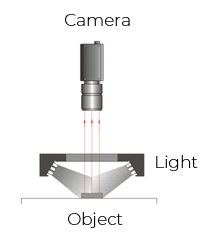Industrial Machine Vision SWIR Ring Light 3 Series
 Ring light are industrial LED lights for illuminating products in machine vision applications like surface defects on organic materials, sort foreign material and identify different materials with a computer vision system. Our SWIR ring light are available in different sizes and wavelengths to suit various computer vision needs. If you can't find the right size, we can customize the ring light combined to fit your illumination request. Click here for the datasheets.
Ring light are industrial LED lights for illuminating products in machine vision applications like surface defects on organic materials, sort foreign material and identify different materials with a computer vision system. Our SWIR ring light are available in different sizes and wavelengths to suit various computer vision needs. If you can't find the right size, we can customize the ring light combined to fit your illumination request. Click here for the datasheets.
When to use SWIR ring light in your machine vision application?
Ring lights are the most commonly used lights in machine vision applications. They are very versatile. You can use them in combination with our SWIR industrial cameras in computer vision applications where you are inspecting:
- Flat objects where you want to measure edges or detect surface defects
- Objects that are round
In case an object is not flat and reflective, we strongly recommend using a dome light for illuminating your product.
How to use SWIR ring light for illumination in computer vision
Ring lights are commonly used in machine vision applications. We recommend using the power supplies as indicated in the datasheet to control the brightness of the ring light, optimizing illumination for your computer vision tasks. Additionally, these power supplies give you the option to trigger the ring light. Triggering the ring light will increase the lifespan of the ring light combined.
Overview of SWIR ring lights
|
Model
|
Type
|
LED Rows
|
Emitting surface A (mm) |
Voltage (V)
|
Dimensions
B(mm)
|
Weight
(gram)
|
Express Stock
|
|
VA1-SWIR-RL-50-75
|
Ring
|
3 |
⌀28x⌀90 |
24
|
50x28x16
|
120
|
No
|
|
VA1-SWIR-RL-90-70
|
Ring
|
3
|
⌀50x⌀90 |
24
|
90x50x20
|
150
|
No
|
|
VA1-SWIR-RL-120-75
|
Ring
|
3
|
⌀65x⌀120 |
24
|
120x65x17
|
210
|
No
|
*Tolerance +/- 10%
Delivery time
If the ring light is on express stock and you order with express handling, the ring light will be shipped in 1–2 days.
When the ring light is not on express stock, it has to be custom produced and will be shipped after 4–6 weeks.
Download SWIR ring light datasheet
In our ring light datasheet you find the mechanical dimensions, wavelengths, operating temperature, compatible power supplies and so on. Login using your email address and get instantly access to our ring light datasheets.
Production and quality control of SWIR ring light
Our LED ring lights are produced with a strict process of quality control, to ensure their reliability and consistency. Upon receiving a new batch of LEDs, the quality department completes a comprehensive check to test whether the wavelength falls within the specified tolerances. Approved LEDs are stored in a climate chamber, ready for use in production. The next stage of ring light production is automated and involves placing the LEDs on a PCB that fits the ring light, which is then followed by an inspection and soldering. Moving along the production line, the LED boards are assembled into the mechanical housing of the ring light. Post-assembly, the ring light undergoes testing to ensure that it performs according to its specification. This critical phase ensures that each ring light unit meets our uncompromising quality standards.
The production process of the ring light may also include the creation of a diffuser or polarizer. The diffuser is cut automatically, and every batch of diffuser plates undergoes transparency testing before they are cut into the correct shape. The final step involves a comprehensive quality check, where the intensity, voltage, and current of each ring light are meticulously measured. This step guarantees that all machine vision lights that leave our facility meet the required specifications. To further ensure the long-term consistency of our ring light, we have established a room dedicated to light-source age testing.
During the R&D phase of a new ring light, it will be continuously on for 1 week, while the temperature is monitored. For every new production run, each ring light will be continuously powered for 12 hours, ensuring that the quality and output of our machine vision lights remain uniform over time.
